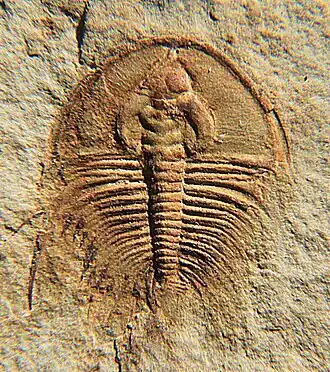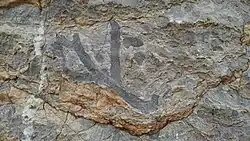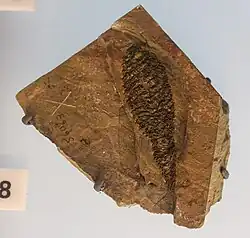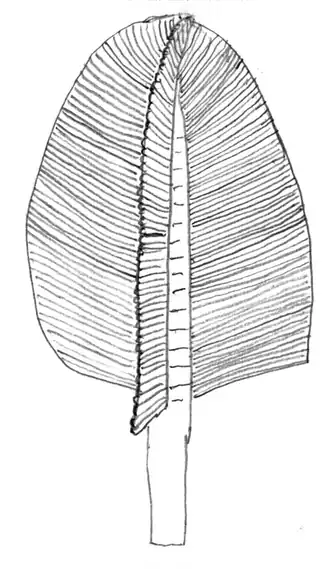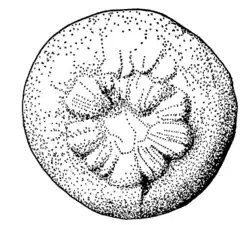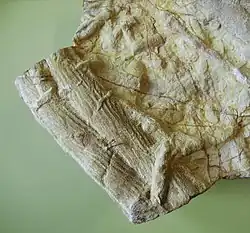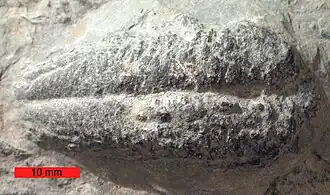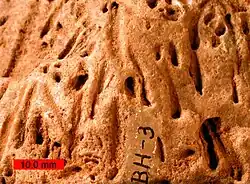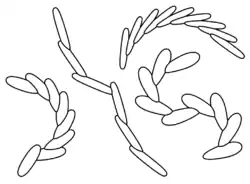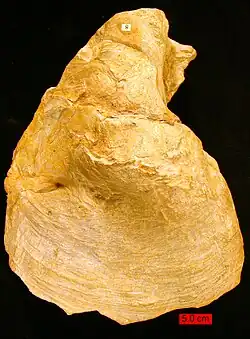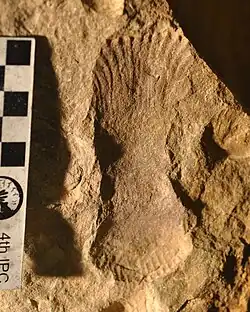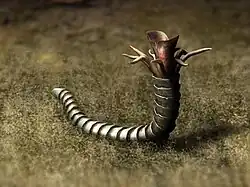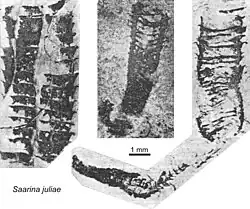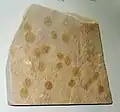The Wood Canyon Formation is a geologic formation in the northern Mojave Desert of Inyo County, California and Nye County and Clark County, Nevada .[ 2] [ 3]
It can be seen in the Panamint Range and Funeral Mountains adjoining Death Valley , within Death Valley National Park ; and in the Spring Mountains in Clark County.[ 2]
Geology
The 570+ million years old formation underlies the Zabriskie Quartzite Formation, and overlies the Stirling Quartzite Formation .[ 2] [ 4]
It has three unnamed Members, simply known as 'Upper', 'Middle', and 'Lower', that mainly consist of limestone , conglomerate rocks and dolostone respectively, with sandstone and siltstones found within the 'Upper' and 'Lower' Members, with the latter itself further containing quartzite and shales .[ 1] [ 2] Cambrian in age, including the upper rocks of the 'Lower Member', whilst the rest of the 'Lower' Member is Ediacaran in age.[ 1]
Paleobiota
The Wood Canyon Formation spans from the late Ediacaran period of the Neoproterozoic Era into the Lower Cambrian Period of the Paleozoic Era .[ 2] [ 3] [ 5] olenellid trilobites and archaeocyathid sponges ,[ 2] petalonamid forms like Pteridinium ichnotaxon traces like Helminthoidichnites .[ 1]
Color key
Notes small text ; crossed out taxa are discredited.
Cambrian
All the organisms and trace fossils from the Cambrian sections of the formation.
Arthropoda
Genus
Species
Notes
Images
Olenellidae indet.[ 2]
Redlichiid trilobite arthropods.
Nevadia (?)[ 2]
Redlichiid trilobite arthropods, from the family Nevadiidae. Misslabelled as Nevadella gracile , tentative assignment.
Brachiopoda
Genus
Species
Notes
Images
Kutorgina (?)[ 2]
Rhynchonelliform brachiopods, tentative assignment.
Genus
Species
Notes
Images
Archaeocyatha indet.[ 2]
Marine reef-building sponges.
Echinodermata
Petalonamae
Genus
Species
Notes
Images
Swartpuntia [ 7]
Sessile frondose organism, although assignment has been questioned based on the possibility that know specimens could be referred to other known Cambrian frondose organisms. [ 8]
incertae sedis
Genus
Species
Notes
Images
Tirasiana (?)[ 7]
Discoidal organism, tentative assignment. Possibly junior synonym of Aspidella .
Ichnogenera
Ediacaran
All the organisms and trace fossils from the Ediacaran sections of the formation.
Petalonamae
Genus
Species
Notes
Images
Charnia (?)[ 1]
Sessile frondose organism, tentative assignment.
Ernietta [ 13] [ 14]
Sessile bag-like frondose organism. Reclassified as Tulaneia.
Pteridinium [ 1]
Frondose organism.
Swartpuntia [ 13]
Sessile frondose organism, assignment has been questioned due to poor preservation. [ 8]
Tulaneia [ 15]
Sessile bag-like frondose organism.
incertae sedis
Genus
Species
Notes
Images
Archaeichnium [ 13]
Tubular organism. A recent 2017 suggests reported specimens may instead be poorly preserved Gaojiashania specimens,[ 14]
Costatubus [ 16]
Tubular fossil, first occurrence in this formation and new species. A study done in the same year discovered some of the first remains of cloudinomorph soft-tissue material within the tubes, resembling bilaterian-like through-guts, which would also make them the oldest known guts in the fossil record.[ 17]
Cloundina [ 13]
Tubular organism. A recent 2017 suggests reported specimens may instead be poorly preserved Gaojiashania specimens,[ 14]
Conotubus [ 14]
Tubular organism.
Corumbella [ 13] [ 14]
Tubular organism.
Gaojiashania [ 14]
Tubular organism.
Saarina [ 16]
Tubular fossil, first occurrence in this formation and new species. A study done in the same year discovered some of the first remains of cloudinomorph soft-tissue material within the tubes, resembling bilaterian-like through-guts, which would also make them the oldest known guts in the fossil record.[ 17]
Nimbia (?)[ 13]
Discoid organism, tentative assignment.
Onuphionella [ 13]
Tubular organism, first known occurrence in Ediacaran aged rock. A recent 2017 suggests reported specimens may instead be poorly preserved Gaojiashania specimens,[ 14]
Ichnogenera
Genus
Species
Notes
Images
Helminthoidichnites [ 10]
Burrows.
Palaeophycus [ 10]
Burrows.
Planolites [ 10]
Burrows.
Bilobate trails[ 10]
Trails, bears similarities with the ichnogenus Scolicia
Undescribed
Genus
Species
Notes
Images
Conical calcareous fossils[ 13]
Calcareous fossils that are conical in shape, although their poor preservation hinders any proper assignments. They have been suggested to represent the well-known and common organism Cloudina Wyattia , or even a new genus.
Enigmatic tubular fossils[ 14]
Various pyritized tubular forms ranging from 0.3 to 7 cm in length and 1 to 5 mm in diameter.
See also
References
^ a b c d e f Evans, Scott D.; Smith, Emily F.; Vayda, Prescott; Nelson, Lyle L.; Xiao, Shuhai (October 2024). "The Ediacara Biota of the Wood Canyon formation: Latest Precambrian macrofossils and sedimentary structures from the southern Great Basin". Global and Planetary Change . 241 : 104547. Bibcode :2024GPC...24104547E . doi :10.1016/j.gloplacha.2024.104547 . ^ a b c d e f g h i j k Hunt, C B; Mabey, D (1966). "Stratigraphy and structure, Death Valley, California". Geological Survey Professional Paper . Bibcode :1966usgs.rept...12H . doi :10.3133/pp494A . ^ a b Digital-desert.com: "Death Valley Geology - Wood Canyon Formation" ^ Springer.com: "Tidal Deposits in the Zabriskie Quartzite (Cambrian), Eastern California and Western Nevada" ; John J. Barnes, George deVries Klein.^ Various Contributors to the Paleobiology Database. "Fossilworks: Gateway to the Paleobiology Database" . Retrieved 17 December 2021 . ^ Durham, J. W. (1993). "Observations on the Early Cambrian Helicoplacoid Echinoderms" . Journal of Paleontology . 67 (4): 590– 604. Bibcode :1993JPal...67..590D . doi :10.1017/S0022336000024938 . ISSN 0022-3360 . JSTOR 1305933 . ^ a b Hagadorn, James W.; Fedo, Christopher M.; Waggoner, Ben M. (2000). "Early Cambrian Ediacaran-Type Fossils from California" . Journal of Paleontology . 74 (4): 731– 740. doi :10.1666/0022-3360(2000)074<0731:ECETFF>2.0.CO;2 . ISSN 0022-3360 . JSTOR 1306951 . ^ a b Runnegar, Bruce; Gehling, James G.; Jensen, Sören; Saltzman, Matthew R. (October 2024). "Ediacaran paleobiology and biostratigraphy of the Nama Group, Namibia, with emphasis on the erniettomorphs, tubular and trace fossils, and a new sponge, Arimasia germsi n. gen. n. sp" . Journal of Paleontology . 98 (S94): 1– 59. Bibcode :2024JPal...98S...1R . doi :10.1017/jpa.2023.81 ^ a b c Mata, Scott A.; Corsetti, Cara L.; Corsetti, Frank A.; Awramik, Stanley M.; Bottjer, David J. (2012). "Lower Cambrian Anemone Burrows from the Upper Member of the Wood Canyon Formation, Death Valley Region, United States: Paleoecological and Paleoenvironmental Significance" . PALAIOS . 27 (9/10): 595– 607. Bibcode :2012Palai..27..594M . doi :10.2110/palo.2012.p12-016r . ISSN 0883-1351 . JSTOR 23362118 . ^ a b c d e f g h i Jensen, S; Droser, M; Heim, N. "Trace fossils and ichnofabrics of the Lower Cambrian Wood Canyon Formation, southwest Death Valley area" . ResearchGate . Pacific Section SEPM. Retrieved 2 June 2025 . ^ Corsetti, Frank A.; Hagadorn, James W. (2000). "Precambrian-Cambrian transition: Death Valley, United States". Geology . 28 (4): 299. Bibcode :2000Geo....28..299C . doi :10.1130/0091-7613(2000)28<299:PTDVUS>2.0.CO;2 . ^ Sappenfield, Aaron; Droser, Mary; Kennedy, Martin; Mckenzie, Ryan (November 2012). "The oldest Zoophycos and implications for Early Cambrian deposit feeding". Geological Magazine . 149 (6): 1118– 1123. Bibcode :2012GeoM..149.1118S . doi :10.1017/S0016756812000313 . ^ a b c d e f g h Hagadorn, James W.; Waggoner, Ben (2000). "Ediacaran Fossils from the Southwestern Great Basin, United States" . Journal of Paleontology . 74 (2): 349– 359. Bibcode :2000JPal...74..349H . doi :10.1666/0022-3360(2000)074<0349:EFFTSG>2.0.CO;2 . ISSN 0022-3360 . JSTOR 1306912 . ^ a b c d e f g h Smith, E. F.; Nelson, L. L.; Tweedt, S. M.; Zeng, H.; Workman, J. B. (12 July 2017). "A cosmopolitan late Ediacaran biotic assemblage: new fossils from Nevada and Namibia support a global biostratigraphic link" . Proceedings of the Royal Society B: Biological Sciences . 284 (1858): 20170934. Bibcode :2017RSPSB.284....1S . doi :10.1098/rspb.2017.0934 . PMC 5524506 PMID 28701565 . ^ Runnegar, Bruce; Horodyski, Robert J.; Gehling, James G.; Jensen, Sören; Bengtson, Stefan; Peterson, Kevin J.; Saltzman, Matthew R.; Vendrasco, Michael J. (November 2024). "Tulaneia amabilia n. gen. n. sp.: a new erniettomorph from the Wood Canyon Formation, Nevada and the age of the Ediacaran–Cambrian transition in the Great Basin" . Journal of Paleontology . 98 (6): 929– 951. Bibcode :2024JPal...98..929R . doi :10.1017/jpa.2024.45 ^ a b Selly, Tara; Schiffbauer, James D.; Jacquet, Sarah M.; Smith, Emily F.; Nelson, Lyle L.; Andreasen, Brock D.; Huntley, John Warren; Strange, Michael A.; O’Neil, Gretchen R.; Thater, Casey A.; Bykova, Natalia; Steiner, Michael; Yang, Ben; Cai, Yaoping (16 February 2020). "A new cloudinid fossil assemblage from the terminal Ediacaran of Nevada, USA". Journal of Systematic Palaeontology . 18 (4): 357– 379. Bibcode :2020JSPal..18..357S . doi :10.1080/14772019.2019.1623333 . ^ a b Schiffbauer, James D.; Selly, Tara; Jacquet, Sarah M.; Merz, Rachel A.; Nelson, Lyle L.; Strange, Michael A.; Cai, Yaoping; Smith, Emily F. (10 January 2020). "Discovery of bilaterian-type through-guts in cloudinomorphs from the terminal Ediacaran Period" . Nature Communications . 11 (1): 205. Bibcode :2020NatCo..11..205S . doi :10.1038/s41467-019-13882-z . PMC 6954273 PMID 31924764 .
